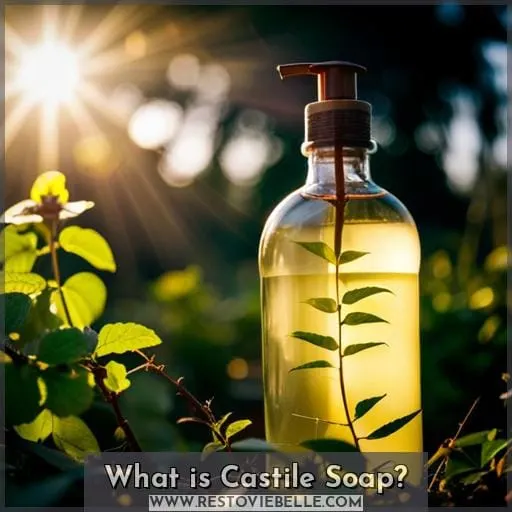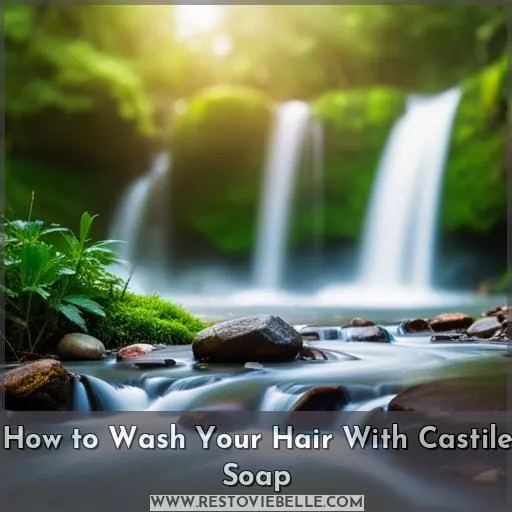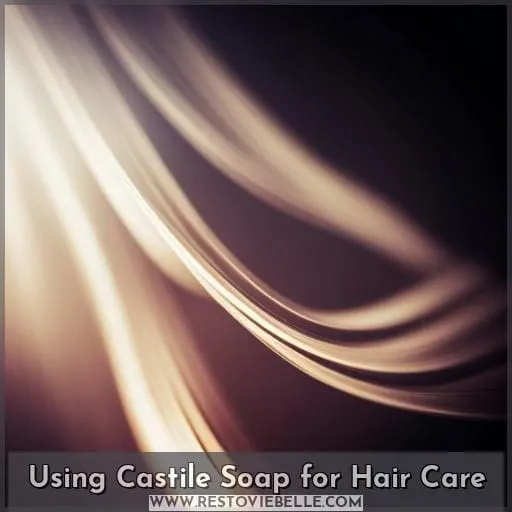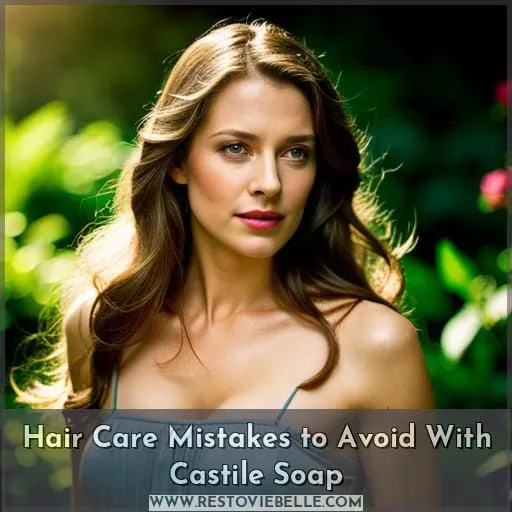This site is supported by our readers. We may earn a commission, at no cost to you, if you purchase through links.
 Are you looking for a natural way to boost your hair’s growth? Castile soap may be the answer. This vegetable-based, non-toxic soap has antimicrobial properties that can help protect your scalp and hair from damage while also preserving its natural oils.
Are you looking for a natural way to boost your hair’s growth? Castile soap may be the answer. This vegetable-based, non-toxic soap has antimicrobial properties that can help protect your scalp and hair from damage while also preserving its natural oils.
Plus, it is mild enough for use on sensitive scalps and helps reduce inflammation too! In this article, we will explore the benefits of using castile soap for hair care as well as how to safely incorporate it into your routine with DIY recipes.
So if you’re interested in learning more about the potential of castile soap for stimulating healthy growth, read on!
Table Of Contents
- Key Takeaways
- What is Castile Soap?
- The Benefits of Using Castile Soap for Hair
- How to Wash Your Hair With Castile Soap
- DIY Castile Soap Recipes for Healthy Hair
- What Does Castile Soap Do for Your Hair?
- Using Castile Soap for Hair Care
- Is Castile Soap Good for Hair Care?
- Hair Care Mistakes to Avoid With Castile Soap
- Frequently Asked Questions (FAQs)
- Conclusion
Key Takeaways
- Castile soap is a natural alternative to regular shampoo that promotes hair growth.
- It maintains scalp health and preserves natural oils, making it suitable for sensitive scalps.
- The soap’s antimicrobial properties protect the scalp and hair from damage.
- The antioxidants present in Castile soap combat free radicals and promote healthy hair growth.
What is Castile Soap?
You may be wondering what Castile soap is and how it can help with hair growth. Castile soap is a plant-based, gentle alternative to regular shampoo that originated in Spain. It has many beneficial properties for scalp health and maintaining natural oils.
It’s non-irritating and non-drying, while preserving the essential oils needed for healthy hair. Castile soap has antimicrobial properties that keep sebum levels balanced, while antioxidants combat free radicals to promote growth.
Castile soap is suitable for various types of scalps, from itchy irritations to dryness. However, it should always be diluted with water due to its alkaline nature before use. After washing with castile soap, it’s recommended to finish off the post-wash routine with an acidic rinse like lemon juice or apple cider vinegar.
If you have color-treated hair, take caution as higher pH levels could strip away dye. However, organic sugar soaps still provide great benefits without compromising your hue. Additionally, for those dealing with waxy build-up, a natural bristle brush combined with bar forms of castile soap can effectively get rid of unwanted residue between washes.
With all these tips, you’re sure to find success on this new journey towards healthier locks using this age-old remedy known as castile soap!
The Benefits of Using Castile Soap for Hair
You may have heard of castile soap as a natural alternative to regular shampoo, and it’s true! Castile soap is gentle, non-irritating, and non-drying for your scalp.
Here are some great benefits of using this plant-based cleansing agent:
- Scalp Health: Its antimicrobial properties help preserve sebum, which keeps the scalp healthy.
- Transition Tips: To successfully transition from shampoo, you’ll need to adjust the pH balance with diluted castile soap and an acidic rinse like lemon juice or apple cider vinegar afterwards.
- Moisturizing Oils: After washing with castile soap, use moisturizing oils such as coconut oil or jojoba oil on damp hair for extra hydration.
- Different Varieties & DIY Recipes Available: Liquid forms can be found in different Dr. Bronner soaps that suit specific types/conditions. Try making peppermint-based shampoos or lavender bars yourself too! With proper care and maintenance, you will notice stronger, healthier strands over time without drying out existing ones.
How to Wash Your Hair With Castile Soap
When washing your hair with Castile soap, it is important to dilute the soap and follow up with an acidic rinse such as lemon juice or apple cider vinegar. To help maintain scalp health, use a natural oil like coconut or argan after rinsing for additional moisturization.
Taking these steps will ensure that you get the most out of using Castile Soap for healthy hair growth.
Dilute the Soap
Diluting the soap in water is essential for maintaining your scalp pH balance and keeping it healthy. When transitioning from shampoo to castile, use a 1:1 water ratio to avoid over-drying or irritating.
An acidic rinse of lemon juice or apple cider vinegar helps restore natural oils and maintain oil balance. Dr. Bronner’s soaps provide different options for deep conditioning with olive oil, lavender oil, etc.
But remember less is more! Adjust the soap/rinse combination as well as using coconut milk can help combat dryness and waxy buildup.
Use a Post-Wash Acidic Rinse
After washing, balance your scalp’s pH levels with an acidic rinse like lemon juice or apple cider vinegar. This helps maintain natural oils and promotes healthy hair growth while preserving acidity levels for a nourished scalp.
Not only does the acidic conditioning rinse support stronger locks, but it also prevents dryness caused by using shampoo and castile soap alone.
For homemade shampoos, add ingredients like tea tree oil or peppermint to combat dandruff and itchy scalps without disrupting pH balance – essential for effective castile soap for hair growth! Discover which recipes work best to reduce irritation and fortify strands naturally; there’s no need for expensive store-bought products!
The end result? Healthier-looking tresses that feel soft all day long.
Moisturize With an Oil
After washing your hair with castile soap, use an oil to moisturize it for a healthy and nourished look. Choose from vegetable oils like coconut or hemp oil, which help maintain scalp health and pH balance.
Combat free radicals that can damage the hair by using antioxidant-rich pure-castile soaps or lemon juice rinse after shampooing. If needed, clarifying shampoos can help get rid of any buildup caused by the soap.
Also, consider adding in some aloe vera for extra hydration! Lastly, be sure to select an appropriate oil depending on your individual needs.
DIY Castile Soap Recipes for Healthy Hair
Crafting your own Castile soap shampoo recipes is an effective way to achieve healthy hair. From Lavender and Almond Oil Castile Soap Shampoo, Peppermint and Tea Tree Castile Shampoo, to Clove Oil and Castile Soap Anti-Dandruff Shampoo – these natural ingredients can help promote hair growth while maintaining scalp health.
Lavender and Almond Oil Castile Soap Shampoo
Try making your own all-natural shampoo with a mixture of lavender and almond oil Castile soap for luscious locks! For scalp health, it has moisturizing effects to help prevent dryness, color stripping, and dandruff control.
Oil balancing helps maintain free radicals, while water softening prevents scum buildup. DIY recipes are easy; mix in tea tree oil or peppermint for extra benefits! Troubleshooting is simple too: adjust rinse strength if hair feels waxy or greasy after use.
Peppermint and Tea Tree Castile Shampoo
Experience a refreshingly minty scalp with the invigorating combination of peppermint and tea tree castile soap shampoo. Peppermint oil is great for treating dandruff, while tea tree oil works to keep your scalp healthy.
This DIY shampoo is suitable for all hair types. It helps balance pH levels and encourages hair growth without stripping away natural oils. Vegetable-based castile soap makes this an ideal choice if you’re looking for a gentle yet effective cleansing option that’s free from harsh chemicals or synthetic fragrances.
Looking to make your own? Grab some essential oils, vegetable-based soaps like Dr.
Clove Oil and Castile Soap Anti-Dandruff Shampoo
Combat dandruff and scalp infections with a homemade shampoo of clove oil and castile soap for revitalized, healthy hair. Clove oil provides powerful antimicrobial properties to fight infection-causing bacteria while soothing the scalp from irritation.
Castile soap is derived naturally from olive oils, promoting an ideal pH balance on your head while gently cleansing without stripping natural oils or color-protecting pigments in dyed hair.
What Does Castile Soap Do for Your Hair?
You may have heard of Castile soap, a natural alternative to regular shampoo that originates from olive oil. It is known for its hydrating and soothing properties, which make it great for people with sensitive or irritated scalps.
Not only does this plant-based soap reduce inflammation, but its antioxidants also work as a shield against free radicals for healthier hair growth. However, you should always dilute the Castile soap before use and follow up with an acidic rinse like lemon juice or apple cider vinegar to balance out your scalp pH level.
Hydrates the Scalp and Hair
Using Castile soap on your hair and scalp helps to hydrate them both, leaving you with soft, shiny locks. Plus, studies show that regular use of this natural alternative can lead to up to 40% more moisture in the hair after just a few weeks.
pH adjustment is key for proper oil balance and scalp health when using Castile soap recipes such as lavender & almond oil or clove oil & Castile. Greasy hair may require less rinse, but also watch water quality during washes – grapeseed oil works wonders! Free radicals are combatted by antioxidants, which promote growth while preserving sebum levels too.
Great for Soothing Sensitive or Irritated Scalp
Castile soap is great for soothing sensitive or irritated scalps because it’s gentle and non-irritating. This helps preserve natural oils. It’s important to maintain pH balance when using castile soap on color-treated hair.
To do this, avoid hard water, as it can strip away hair color. After washing with the soap, it’s beneficial to use oil treatments like coconut or argan oil to replenish hydration levels in the scalp and strands.
Different types of Dr. Bronner’s Castile Soaps are available to cater to specific needs, such as dry skin, eczema-prone skin, and even dandruff issues. For those with sensitive scalps, this type of product could be a godsend. It gently cleanses without irritation while hydrating at the same time.
Reduces Inflammation and Protection From Free Radicals
Antioxidants in castile soap can help protect your hair from free radicals, reducing inflammation and promoting healthy growth. It contains natural ingredients like olive oil, which helps to moisturize the scalp and balance pH levels when transitioning on a hair journey.
Castile soap is alkaline, so it’s important to dilute it with water before use or risk stripping away dyes from dyed hair.
Dilute the Castile Soap Before Use
To ensure your hair stays healthy and vibrant, it’s important to dilute the castile soap before you use it. Otherwise, its powerful alkaline properties can feel like a tsunami on your scalp! Diluting with filtered water prevents scum formation, while adjusting the rinse balance helps keep pH levels in check.
Coconut milk or apple cider vinegar are great acidic rinses that help combat wax buildup. Bar soaps are better for oily hair compared to liquid plant-based soap, which is best suited for dry scalps. Handmade shampoo bars infused with essential oils boost hair growth rate without sacrificing the chemical-free alternative of regular shampoos.
Subtly varying up your routine will keep things interesting. Try different recipes and see what works best for you!
Always Use a Post-Wash Acidic Rinse
Following up your Castile soap wash with an acidic rinse helps maintain the natural oils in your scalp and keeps it healthy for optimal hair growth. It also balances out the alkaline nature of Castile soap, preventing color fading and waxy buildup on strands.
A clarifying mix made from baking soda is ideal for relieving a dry or itchy scalp while helping to remove buildup that causes brittle ends.
Incorporating a natural alternative like Castile soap into your routine will leave you feeling refreshed – without sacrificing any moisture or comfort – as you enjoy its benefits such as relief from itching and softness throughout every strand!
Using Castile Soap for Hair Care
Looking for a natural hair care solution? Castile soap is an economical and customizable option. The Lavender Oil Castile Shampoo Bar promotes relaxation and hair growth, while the Anti-Dandruff Castile Shampoo combats dandruff and scalp infections.
Lavender Oil Castile Shampoo Bar
Try making a lavender oil Castile shampoo bar to soothe and relax your scalp while promoting hair growth. Lavender oil has beneficial properties that can help reduce dandruff, encourage healthy scalp care, and strengthen brittle hair.
Clove oil is an excellent addition to this DIY recipe as it can aid in preventing fungal infections on the scalp.
With these two ingredients combined with castile soap for cleansing, you will have all the necessary components needed for natural hair care recipes! Add other nourishing ingredients like coconut milk or argan oils to boost the benefits of this homemade shampoo bar even further!
Get creative by experimenting with different combinations of hair-benefiting ingredients until you find one that works best for your needs. Whether using liquid or bar forms of castile soap, make sure to adjust pH levels accordingly when transitioning from regular shampoos and use minimal amounts where possible to avoid disrupting scalps’ delicate balance.
Anti-Dandruff Castile Shampoo
Combat dandruff and scalp infections with an anti-dandruff castile shampoo: studies show that 90% of people with dandruff have seen improvements after using a natural, plant-based alternative. Clove oil is the key ingredient for effective hair cleansing and moisturizing. Dilute castile soap, then rinse with an acidic solution like lemon juice or apple cider vinegar to balance pH levels on your scalp.
Natural beauty bloggers swear by this routine – try it out if you’re struggling from dryness or irritation! For maximum results, use minimal soap to prevent disrupting the delicate pH balance while still getting clean hair.
As always, follow up washing sessions by sealing in moisture with coconut oil or other natural oils recommended by experts for best results!
Is Castile Soap Good for Hair Care?
Discover the natural benefits of using Castile soap for healthier hair! Consider dandruff prevention, color protection, and pH balance – just some of the advantages that make it a great alternative to conventional shampoos.
With its oil moisturizing properties and ability to support hair growth, this gentle cleanser is perfect for all types of hair care products. Hair cleansing methods with Castile soap are simple yet effective; an ideal solution in any routine or lifestyle.
Start off by diluting it with water and adjusting your scalp’s pH levels accordingly before applying onto wet strands.
Although you may feel overwhelmed initially when switching from traditional shampoos over to Castile soap-powered haircare solutions, trust that taking time will show positive results in no time!
Hair Care Mistakes to Avoid With Castile Soap
When it comes to using castile soap for hair growth, there are certain mistakes you should avoid. Don’t use this natural product on dyed or color-treated hair as its high pH can strip the dye; instead, opt for filtered water when diluting your castile soap shampoo and be sure to follow a homemade recipe that suits your individual needs.
Don’t Use Castile Soap on Dyed Hair
Avoid using castile soap on dyed hair like the plague, or you may regret it later. High pH levels in castile soap can lead to bleaching effects and color fading, as well as damage to your hair such as breakage and loss.
It can even strip away dye that has been applied previously! Color-treated hair should be washed with a shampoo free of artificial fragrances or harsh detergents instead of being used as a replacement for shampoo altogether.
When it comes to transitioning from regular shampoos, understanding the consequences of common mistakes is essential for successful reconstruction efforts.
Don’t Use Hard Water to Dilute Castile Soap
Hard water shouldn’t be used to dilute your Castile soap because it can cause scum formation. This scum can potentially damage and dry out your hair. Instead, use filtered or distilled water to maintain the pH balance of color-treated hair.
To protect your scalp, consider using an acidic rinse with vinegar or lemon juice. If you’re dealing with waxy buildup or excessive oiliness, try mixing baking soda into your shampoo. It’s important to consider your hair type and any transitions in your hair care routine.
Additionally, you may need to address the hard mineral content in tap water by using softening options like reverse osmosis systems. All of these factors are crucial for achieving healthy hair growth with Castile soap.
Castile Soap Shampoo Recipe
Try this easy recipe for a homemade Castile soap shampoo to help your hair reach its full growth potential! Studies have shown that using natural ingredients like olive oil can improve the strength and health of locks.
For dandruff remedy, mix up clove oil with Castile, or try peppermint tea tree for color stripping.
Apple cider vinegar makes a great rinse and helps keep the pH balanced – while coconut or argan oil provide moisture post-cleansing.
Avoid hard water when diluting as it may strip colors from dyed hair; use an organic aloe vera instead if you have a sensitive skin type!
A natural bristle brush is key to combating waxy buildup while preserving texture without harsh cleansing alternatives.
Hair care adjustments are essential too: adjust soap/rinse balance, wash less frequently, and moisturize regularly with oils for healthy strands – all part of a successful hair growth journey!
Frequently Asked Questions (FAQs)
How often should I use castile soap for hair growth?
Use castile soap regularly to promote hair growth and maintain a healthy scalp. Transition slowly, adjusting the pH balance with a mild acidic rinse for best results.
What are some alternatives to castile soap for hair care?
Explore natural alternatives to traditional shampoo such as aloe vera, coconut milk, and apple cider vinegar. Enjoy the benefits of gentle cleansing that preserves scalp health while promoting hair growth.
Is castile soap safe for babies and children?
Castile soap is generally safe for babies and children; however, caution should be taken to ensure the product isn’t too harsh. Diluting it with water strikes a perfect balance between gentle cleansing and skin protection – like hitting two birds with one stone! So rest assured, your little ones can reap the benefits of this all-natural hair care solution without much worry.
Can I use castile soap as a body wash?
Yes, you can use castile soap as a body wash! It’s gentle and non-irritating, perfect for sensitive skin. Its antimicrobial properties help preserve sebum, while its antioxidants combat free radicals – all great for your health! Dilute it with water to avoid disrupting the pH balance, and follow up with an acidic rinse like lemon juice or apple cider vinegar.
Are there any side effects of using castile soap for hair growth?
You may experience an adjustment period when transitioning to castile soap for hair growth. Be mindful of scalp pH and use minimal soap to avoid disruption; follow with an acidic rinse, moisturize, and consider a natural oil like coconut or argan.
Conclusion
Castile soap is a natural and economical way to nourish and care for your hair. It’s gentle on sensitive scalps, and its antimicrobial and antioxidant properties help preserve hair and scalp health.
With its range of varieties, you can customize the perfect hair care routine for your needs. For example, you can use a shampoo bar for dry hair, a shampoo with clove oil for dandruff, or a homemade lavender and almond oil mix for hair growth.
However, it’s important to remember to dilute your castile soap with water and use an acidic rinse to maintain the proper pH balance for your hair.
With the right routine, castile soap can help you achieve healthier, fuller hair.














